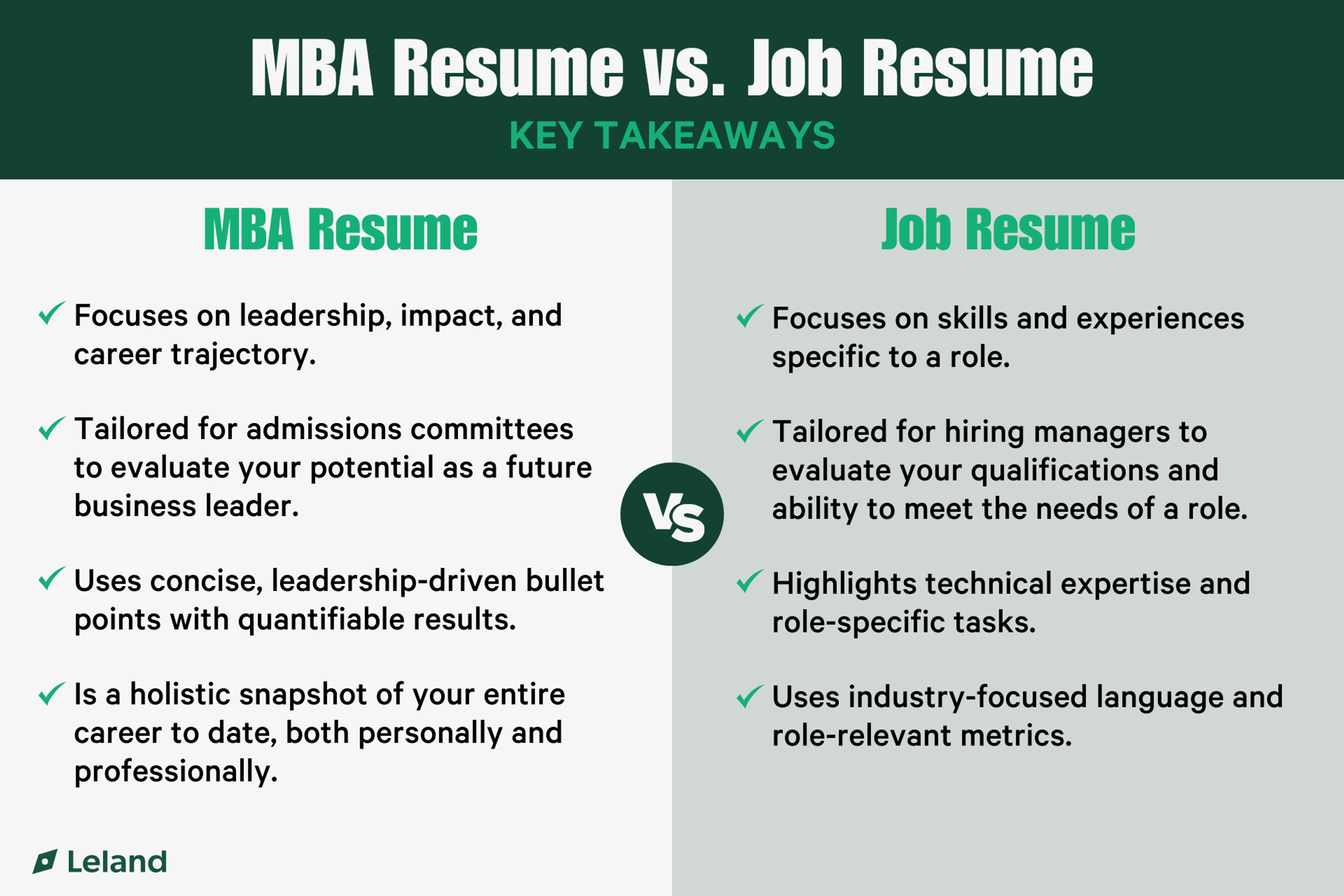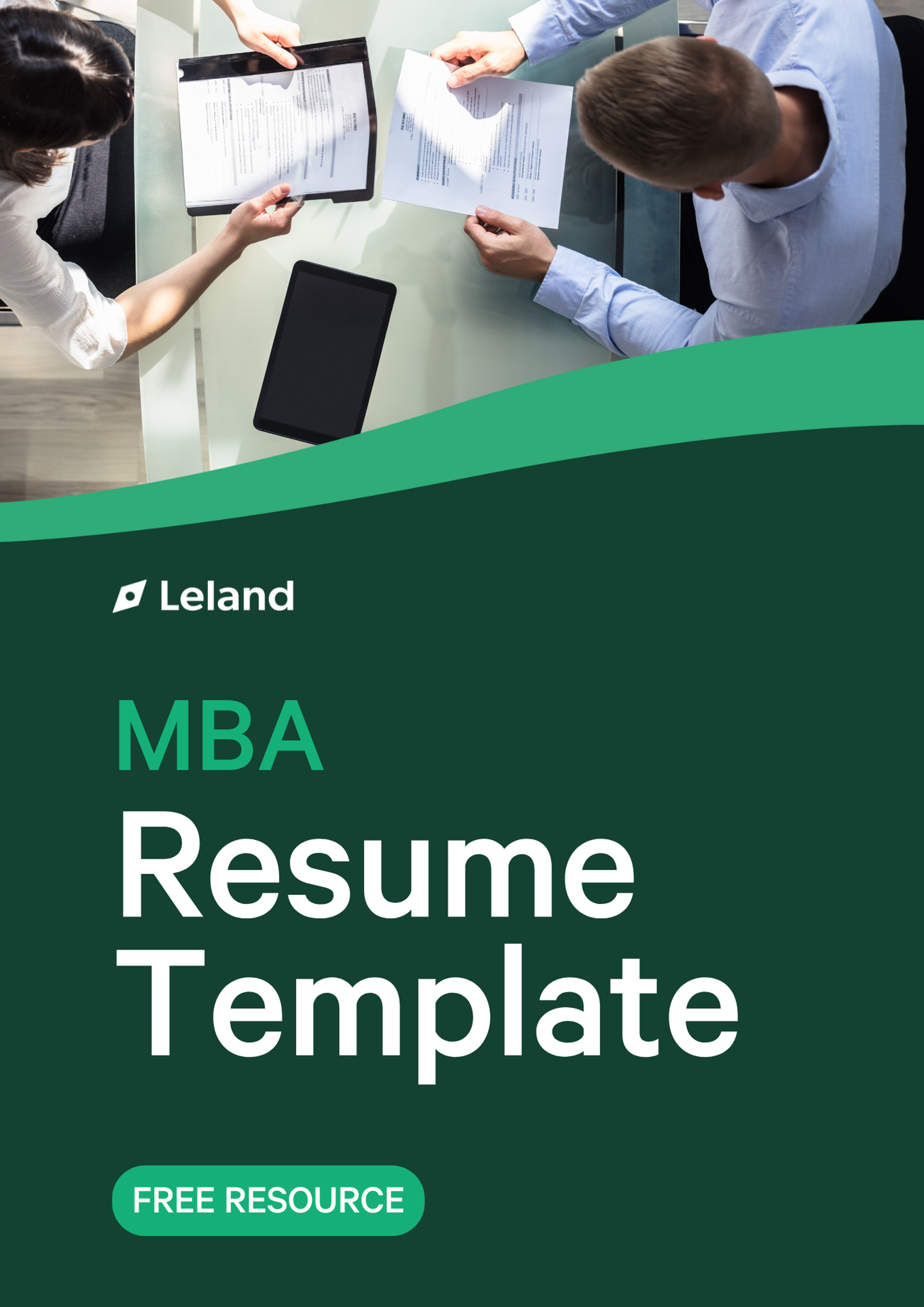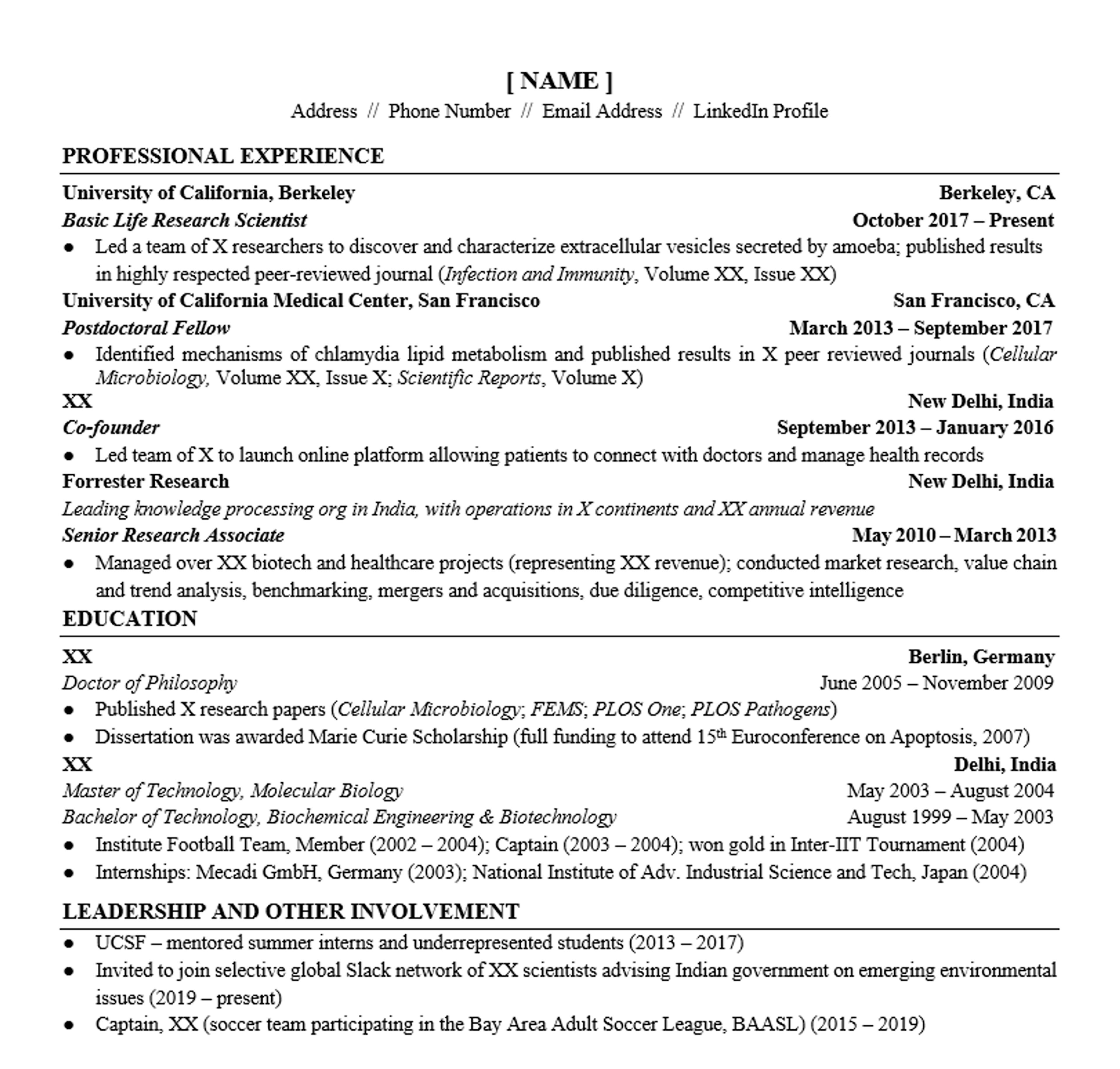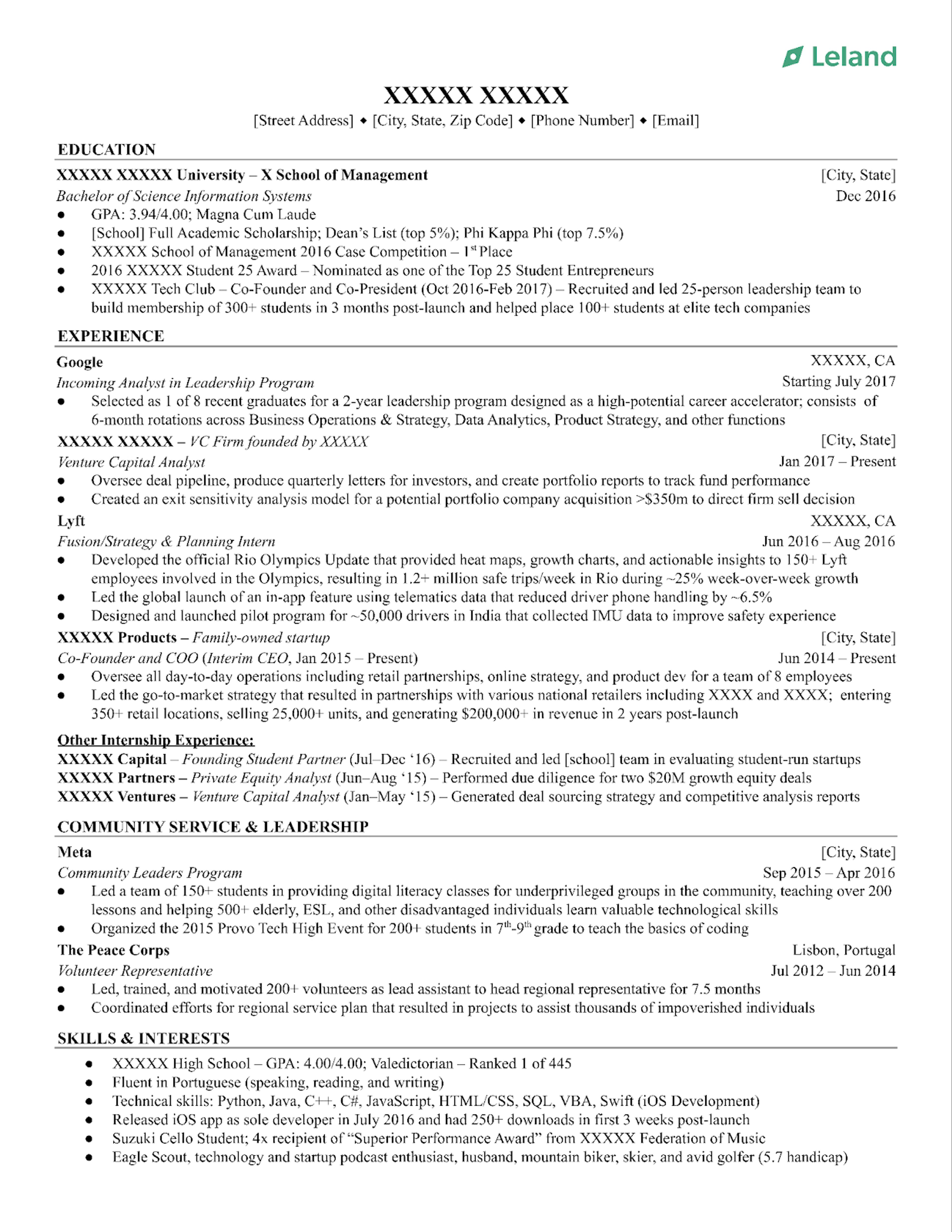MBA Resume Tips, Examples, & Template – From an Ex-AdCom (2025)
MBA resume guide with expert tips, real examples, and a free template. Learn what top business schools like HBS, GSB, and Wharton want to see from a professional consultant and former AdCom.

By Emily L.
Haas Admissions VP I Top 50 Leland Coach I Author and Expert Storyteller
Posted June 19, 2025

Table of Contents
Applying to top MBA programs (Master’s of Business Administration) is a rigorous and competitive process that requires more than just good grades. To truly stand out, you need a comprehensive and polished application package highlighting your achievements, potential, and leadership abilities.
This includes your undergraduate transcript, standardized test score, essays, short answer questions, letters of recommendation, and, just as importantly, your MBA application resume. Each element must work together seamlessly to tell a compelling story about who you are and why you belong at a top business school.
Your MBA resume is one of the most critical pieces of this puzzle. It’s not just a list of past jobs – a comprehensive one-page marketing document showcasing your career growth, skills, and leadership abilities. This document gives the MBA admissions committees a snapshot of your journey so far and hints at your trajectory as a future business leader.
I am a professional MBA admissions consultant, Berkeley Haas MBA and former admissions committee member, and Princeton grad with many years of experience helping applicants gain admission to top programs like Wharton, Kellogg, Columbia, Sloan, and Haas. Since 2017, I’ve professionally coached 100+ MBA applicants from a wide range of backgrounds, including those with below-median test scores, low GPAs, or nontraditional paths.
In this guide, I’ll walk you through everything you need to know to build a strong MBA resume that highlights your leadership, career growth, and potential.
What is an MBA Resume?
The resume is an essential part of your MBA application and one that many applicants tend to underestimate the importance of. But why is it so important? First and foremost, an MBA resume is a one-page highlight reel of your achievements, explicitly tailored for MBA applications. It summarizes your professional achievements, leadership experience, and potential as a future business leader. Unlike a standard job resume, which primarily focuses on skills and experiences relevant to specific roles, the MBA resume objective is to give the admissions committees insight into your professional career trajectory, impact, and qualities that align with an MBA program’s expectations.
Lastly, I have noticed that many MBA programs have cut down on the number and/or length of their essays in recent years, thereby making the resume an even more important part of the application.
1. It's the backbone of your application.
The MBA admissions committee reads the resume for a complete view of your career, professional achievements, extracurriculars, and hobbies. For them, it’s a window into who you are, what you might be like as a student if they admitted you, and how employable you’ll be upon graduation (remember MBA programs want great employment stats to prove their value). So you must nail it!
2. It's critical to your interview.
Your resume will also come into play when interviewing as a source of questions and discussion topics, especially in a blind interview, where an interviewer will only read your resume. Nailing the resume will set you up for success when you reach the interview, that final step in your application process. Each line should be intentional – you have limited space, and anything on there is fair game for interview questions.
Read: How to Ace Your MBA Interview: With Prep Questions & Answers
3. It's your chance to show off your professional journey.
Finally, the resume is your chance to highlight your career progression, the impact you’ve made in your roles, and the skills you’ve developed over time. By describing your accomplishments concretely and concisely, you’ll also be able to signal to the admissions committee that you’re mature, articulate, and knowledgeable about the impact you can make on an organization. Top MBA programs are looking for individuals who are not only accomplished but can convey those accomplishments coherently. Show them you can do that with your resume!
Expert Tip: Your resume is more than a record of your work experience – it’s a strategic tool for showcasing your leadership and potential as an MBA candidate.
What isn't an MBA Resume?
Before we dive into our tips and tricks, it's important to note that your business school resume is categorically different from other resumes you might have previously created, whether for internships, job applications, or other graduate school programs. An MBA resume is not a job resume and should be considered a more comprehensive resume focused on your accomplishments rather than your past roles or projects.
Many prospective MBAs focus on other parts of the business school application, like the GMAT/GRE or their essays, and think they can copy and paste the resume they have on file or the one they recently sent to a recruiter. This, however, would be a huge mistake.
What Makes the MBA Resume Different?
An MBA resume is a different animal. Its job is not to highlight industry knowledge or demonstrate skill proficiency. Instead, the MBA resume must focus on highlighting specific achievements and projects, showcasing teamwork and collaboration, and demonstrating impact. With an MBA resume, you’re not applying for a specific role; rather, you’re applying to join a cohesive, well-rounded class of other high-performing individuals.
Every bullet point on your resume must tell the admissions committee, "This is a stellar MBA applicant who will shine in the future and ultimately make your program look fantastic as a distinguished alum."
How to Use Your Resume to Stand Out
One last thought before we get into the nitty gritty: When you write a job application, you're generally competing with people whose experience and professional background match your own, so you're trying to stand out in a crowd of like applicants. This is why a professional resume can be easier to craft.
When you apply to an MBA program, every single candidate is different, coming from tons of different roles and areas within and outside of the business world. While you're competing against other applicants, you're not trying to outdo them; instead, you're trying to create a holistic snapshot of your career to date – one that fits on a single page touches on all the majority of key aspects of your personal and professional life, and demonstrates that you're a star candidate.
For more tips on crafting a standout MBA application, check out our Ultimate MBA Application Guide
MBA Resume vs. Job Application Resume

Key Takeaways
- The MBA resume is the foundation of your application. It provides a complete view of your career, achievements, and skills, helping admissions officers evaluate your performance to date and your potential.
- The resume is critical in the MBA interview, guiding questions and discussions, especially in blind interviews.
- The resume should tell the story of your career thus far. It should highlight your progression, impact, and skills developed, demonstrating maturity and articulation.
- An MBA resume differs from a job resume, focusing on your unique achievements, ability to work with others, and overall impact on organizations.
Read:
- The 10 Best MBA Admissions Consultants
- MBA Essay Examples & Tips (From an AdCom)
- MBA Recommendation Letters: How to Ask, Who to Choose, and What Makes a Great One
MBA Resume Format: What it Should Look Like
First and foremost, let’s talk about what a strong MBA resume actually looks like. It may seem like common sense, but you don't want to put effort into your application only to have your resume formatted incorrectly with an odd font size and disjointed sections.
1. Keep it to one page.
Get your MBA resume onto a single page — pure and simple. If you submit a resume that is too long, your application will go to the bottom of the admissions pile.
The only exceptions are if you are applying to executive MBA programs and/or have 10+ years of experience. These are the only instances where you might have enough work experience to warrant more than a one-page resume. I once had a unique client in his mid-40’s applying to the Haas Evening & Weekend program and I let him have two pages to cover his work experience. The admissions committee must’ve agreed with this judgment call because he ultimately got in!
2. Use professional fonts and spacing.
When it comes to the best MBA resume format, simplicity is key. Use professional, easy-to-read fonts like Calibre, Arial, or Times New Roman. I recommend sticking with a font size no smaller than 10 points for the body text and 14 points for headings. Additionally, shoot for at least 0.75” margins on all sides to maintain a balanced and professional appearance.
Remember, admissions committees review thousands of resumes, and cramming too much content on the page can make your resume difficult to read. Avoid distractions and focus on presenting your qualifications clearly and concisely.
3. Stick to a clean, black-and-white design.
When formatting your MBA resume, stick to black and white. Adding colors or graphics can distract from the content and undermine the professional tone you're aiming for. Your goal is to communicate your qualifications clearly and professionally — so avoid unnecessary embellishments.
4. Submit it as a PDF.
Most MBA application portals will specify this, but typically the best MBA resume file type is PDF. PDFs ensure your formatting stays consistent, presenting a clean and polished look no matter where or how it’s viewed.
MBA Resume Template

MBA Resume Template
Craft the perfect MBA resume with our customizable template—download your free copy here.
MBA Resume Sections: What to Include
With the format established, it’s time to focus on what content to include. I’ll walk you through each section to ensure your resume is comprehensive and impactful.
Header
This is fairly intuitive, but make sure to include the following:
- Name
- Address
- Phone number
- LinkedIn profile
Separate the information by vertical lines, dashes, or bullets. It should look like this:

Professional Experience
Your professional experience section is the most critical part of your MBA resume, typically occupying about two-thirds of the document. This is where you highlight your career accomplishments in reverse chronological order, showcasing leadership, teamwork, and measurable results.
The professional experience section is primarily for full-time work experience and applicants to non-deferred programs should not include internships. Internships that are particularly interesting or unusual (overseas internships, working on a farm, for example) or hyper-relevant to post-MBA career goals may be included briefly in the education section later on.
*Deferred MBA candidates should include internships and should also have the education section ahead of the professional experience section, given that in most cases they are still full-time students.
Here are a few tips and tricks for writing a solid professional experience section of your MBA resume:
1. Start With the Company, Role, and Dates
This sounds obvious, but you must first state where you worked, your title, and how long you were in that role.
I have heard repeatedly from admissions committee members that the preferred format for this information is company (left margin aligned) and location (right margin aligned) on the first line, and title (left margin aligned) and dates (right margin aligned) on the next line, as shown below. Previous roles at the same company should just have title and dates. This format makes the most relevant information extremely easy to read.
If any of your employers are not name-brand companies, include a phrase in parentheses after the company name explaining what the company is and does.
- Company and Job Description Examples:
- Leading knowledge processing org in India
- VC firm started by HBS professor, X Name
- Series A startup making education more accessible

2. Nail Your Bullet Points
For each role you list, detail your most significant actions and achievements in bullet point format. Write all bullets in the past tense for professionalism and consistency, unless you are still currently working on the project or initiative.
Expert Tip: Focus on describing impactful achievements rather than listing job duties. For example, instead of stating responsibilities, frame your experience with actions and outcomes like: “Managed cross-functional teams to deliver a $10M project ahead of schedule, resulting in a 15% cost reduction.”
State the specific actions you took, add any leadership elements or collaboration, and the accompanying result to the business to show the admissions committee that you have a track record of positive impact in your past professional roles.
Make sure you are showing organizational-level impact. Ask yourself, “Would the department head of this company care about what I’m writing in these bullet points?” If the answer is “No,” they’re probably not good enough. Each bullet should communicate tangible proof of your actions, as well as how those actions drove the company forward.
A word on the job duty information that I just told you not to highlight and that may constitute a good chunk of your existing resume: I always advise my clients to save that content for potential use in the employment section of the data forms (ie. the actual applications to each MBA program that you fill out online). Many applicants assume that once they’ve reworked their resume to be MBA friendly, they can simply copy/paste that content to the forms. This would be another missed opportunity! The resume and the employment info should work hand-in-hand to paint a complete picture of the applicant’s professional experience, with the resume focused on achievement and impact and the employment info adding additional context about the day-to-day work and any important details about the structure of the applicant’s team or organization.
3. Highlight Leadership
One of the most important qualities MBA programs are looking for is leadership, so highlight this actively. Promote instances where you led groups, teams, and projects whenever possible. Even small things, like organizing a company-wide social event, matter.
- Leadership Examples:
- Managed three marketing interns; oversaw three summer-long intern projects, resulting in 47% customer acquisition growth
- Led global IT team of 5 to automate semiconductor design; reduced cycle cost by 15%
4. Quantify/Specify
For every bullet, be as specific about what you accomplished as possible. What numeric results did your actions drive? How much money did you make or save for your company? What did YOU, personally, do (as opposed to the team)?
Each bullet should communicate tangible proof of your actions, as well as the significance of those actions to the company. The goal is to highlight to the admissions committee that you’re a change agent who can bring about significant, measurable outcomes.
Consider this – everyone does things, so why is what you did important? Why does it matter to the organization?
- Quantifiable Results Examples:
- Oversaw $171M annual R&D budget; provided data analytics for 5 R&D Vice Presidents
- Acquired $2M+ in real estate, realizing an average portfolio ROI of 35%
- 1 of 25 students admitted to the selective non-degree program for post-undergraduate students
Not every meaningful achievement is easily quantifiable, and some types of work lend themselves to metrics more than others. In those cases, include qualitative results to demonstrate importance and positive impact.
5. Use Strong Action Verbs
When describing your accomplishments, don’t settle for non-descriptive words like “worked” and “did.” Aim for more punchy verbs like “executed,” “spearheaded,” and “drove.” (Try not to use the same verb twice.)
It may seem inconsequential, but how you describe your actions matters. When you’re competing against thousands of other applicants, every word counts!
- Action Verb Examples:
- Spearheaded a group of 10 to produce a 2015 Super Bowl TV campaign
- Trained 15 new caregivers on COVID-19 protocols, reducing patient incidence by 34%
- Evaluated asset packages and built net asset value models to forecast production
6. Show Growth
Each of the roles you list should indicate an upward professional trajectory. If you started your career as an Analyst but were advanced to Associate and then Manager, show that in separate headings within that company — admissions committees are looking for up-and-coming stars and quick risers.
Expert Tip: I have had many clients push back on this guidance, stating that they have largely done similar work despite promotions, and I always challenge them to highlight a few different projects or initiatives for each role within the same department. It really does make a difference in how an admissions committee views a candidate’s work experience!
Promotions are a visible signal of growth, of course, but taking on more challenging projects within a role and driving impressive results is just as important.
7. Include Your Soft Skills
While hard skills and technical expertise (i.e., financial forecasting, market research, etc.) are essential, admissions committees also look for soft skills such as communication, teamwork, and problem-solving. Some applicants may simply list these skills at the bottom of their resume (which I do not recommend), but it’s far better for you to provide concrete examples of how you’ve successfully demonstrated them in your past roles. For instance, rather than saying you have good communication skills, highlight them in one of your specific achievements.
- Soft Skills Example:
- Completed project on time and within budget by bringing a cross-functional team of 6 together through clear communication of goals and deadlines.
Education
Now that you've nailed the professional experience section, you can tackle the education section.
For each degree, mention the university, degree/major, date of graduation, GPA, and any honors and distinctions (including things like a senior thesis) and extracurricular involvement - athletics, music, and other clubs or activities. As with your work experience, use bullets to make this information easy to read.
For applicants with myriad academic highlights and extracurriculars, you can keep each entry brief and highlight only the key achievements (if any) along with any research work, projects, etc., that show your leadership skills or exemplary business qualifications. The vast majority of schools’ data forms will have honors/awards and extracurricular/activities sections that will give you an opportunity to provide additional context.
When done right, the education section should look like this:

Leadership, Extracurriculars, and Additional Information
This last section is where you can detail any other leadership qualities, post-collegiate extracurricular involvement and volunteer experience, and personal accomplishments that might distinguish you from other MBA candidates. Depending on how disparate the things you are highlighting in this section are, a header of “Additional Information” may make more sense.
When choosing these bullets, prioritize the ones with the most significant impact: where you led teams at your local charity, implemented a change at your alma mater, spearheaded the fundraising committee for your high school's 5th-year reunion, raised several hundred thousand dollars, etc.
As with the rest of the resume, your goal is to depict leadership skills, the ability to drive results, and a knack for collaboration. And make sure to quantify these bullets as best you can!
It’s also a good general practice to select those bullets that few other candidates could list on their resume: the book you wrote with your State Senator, the community garden you helped plant whose proceeds went to benefit HIV research, the Six Sigma Black Belt certification you earned in your spare time.
Expert Tip: I always advocate for having the final bullet of the resume highlight fun facts or quirky interests that will pique the admissions committees’ interests. Here’s an example:
- Interests: Growing chili peppers and making bottled hot sauce, playing the devil’s advocate at the local debate club, completing extreme fitness challenges for fun (ex. 10,000 burpees in 100 days)
These tidbits often end up being one of the first things asked about in an interview!
Here's a couple examples of how this section might look:

ADDITIONAL INFORMATION (Example) - Venture Investing (July 2022 - Present): Limited Partner at XYZ Ventures, a syndicate & venture fund focused on B2B Enterprise SaaS companies. Provide Operations, GTM, and Sales advisory to portfolio companies. - Volunteering (2021 - Present): Assist low-income families during shopping visits and support inventory management at the Resource & Empowerment Center at Non-Profit A - Interests: CrossFit Athlete: Achieved 11th percentile globally among +180K competitors in the CrossFit Games Open Competition | Skiing (Resort & Backcountry): Certified Graduate of American Institute for Avalanche Research and Education (Level 1) - Miscellaneous: Enjoy reading and writing comprehensive book reports for continuing education, including: A Promised Land by Barack Obama; Shoe Dog by Phil Knight; Principles by Ray Dalio; and many others.
Key Takeaways
- In your professional experience, detail your career achievements, use strong action verbs, and quantify your impact.
- Highlight leadership wherever possible, including instances where you've led teams, projects, or initiatives.
- Utilize the employment section of the data form for role and responsibility information that will help provide a fuller picture of your work.
- For your education history, show degrees, institutions, graduation dates, GPAs, and notable honors or achievements.
- Detail extracurricular activities, any volunteer experience, and unique personal accomplishments in the final section.
My Tips for Crafting a Winning MBA Resume
With the main components in place, let’s wrap up with some final tips to ensure your MBA resume stands out for all the right reasons.
- Don’t Exaggerate: While it may be tempting to inflate your achievements, honesty is essential. Admissions teams will verify your claims, so ensure every accomplishment accurately reflects your experience. Exaggerations can lead to issues during the interview stage or later in the process—keep it real!
- Focus on Your Individual Impact: Focus on your personal contributions and the outcomes you achieved rather than general team or company-wide results. Business schools want to know your unique impact, so be ready with specific examples to discuss in the interview.
- Don’t Use Industry Jargon: Admissions committee members may not be familiar with technical terms in your industry. Prioritize clarity by explaining your achievements in straightforward language. The focus should be on the impact and value of your actions rather than the technical specifics.
- Proofread Carefully: A polished resume is critical. Double-check for grammar, punctuation, and formatting errors, which can detract from your professionalism. A clean, error-free resume shows your attention to detail and dedication.
- Add a Personal Touch (Don’t Be a Robot): Admissions officers review countless MBA applications, so a hint of personality can make yours memorable. Use the final section of your resume to share unique hobbies or interests that reflect who you are beyond your professional life.
Examples:
- Avid reader of Asian American novels and films (particularly romantic comedies)
- Enthusiastic cyclist and whitewater rafting guide
- Mastered banana bread baking during COVID-19
Other Considerations for an MBA Resume
Should I Include Certifications Like Chartered Financial Analyst (CFA)?
Yes, rigorous certifications like the CFA, CAIA, CPA, etc. should be included. Certifications demonstrate expertise, commitment, and technical skills in a specific field, making them particularly valuable for MBA applicants aiming to progress within or pivot into those fields.. List these in a dedicated “Certifications” bullet in your additional information section or incorporate them within your work experience if they are directly tied to your job responsibilities.
Do I Need an MBA Resume Summary?
No, an MBA resume summary is typically not necessary. Admissions committees focus more on specific achievements and experiences rather than a general overview. Use the space for detailed accomplishments, quantifiable results, and leadership roles.
What Should I Not Include on the MBA Application Resume?
Avoid including unnecessary personal information like your photo, marital status, or social media handles (beyond LinkedIn). Do not list outdated skills, irrelevant work experience, or generic responsibilities without impact. Steer clear of buzzwords or vague descriptions; instead, focus on quantifiable results and leadership examples. And again, keep the resume to one page, as MBA programs prioritize clarity and relevance over length.
MBA Resume Examples
MBA Resume Example #1 (Traditional)

What makes this a good resume?
- The resume is structured with clear sections, making it easy to navigate and quickly identify key qualifications.
- Quantifiable accomplishments, such as leading teams and publishing research, demonstrate measurable impact and leadership ability.
- Showcases a range of experiences across research, entrepreneurship, and consulting, highlighting adaptability and versatility.
- Features leadership roles in professional settings, mentoring programs, and extracurricular activities, emphasizing influence and initiative.
- Academic achievements, including a prestigious scholarship and multiple publications, reflect strong intellectual ability and dedication.
- Includes international education and work experience, showcasing a global mindset and cross-cultural expertise.
- Incorporates extracurricular achievements, adding depth and showing a well-rounded candidate profile.
MBA Resume Example #2 (Deferred)

What makes this a good resume?
- The resume is well-structured with clear sections for education, experience, leadership, and skills, ensuring easy readability.
- Academic achievements such as a high GPA, full academic scholarship, and case competition win highlight strong intellectual and leadership abilities.
- Professional experience demonstrates a mix of prestigious roles at top firms, including Google, Lyft, and venture capital, showcasing versatility and high-impact contributions.
- Leadership roles in startups and community programs emphasize entrepreneurial drive and commitment to social impact.
- Quantifiable results, such as leading growth to $200,000+ in revenue or improving ride safety by 6.5%, illustrate measurable accomplishments.
- Technical skills, multilingual abilities, and extracurricular interests add depth and showcase a well-rounded and dynamic candidate profile.
- Global experience through roles like the Peace Corps Volunteer Representative highlights a commitment to service and cross-cultural collaboration.
Emily L. is a top-rated MBA admissions consultant with extensive experience helping applicants gain admission to leading business schools like Wharton, Kellogg, Sloan, Columbia, Haas, and more.
Emily is a Berkeley Haas MBA with admissions committee experience and a Leland Top 50 Coach. She has coached 100+ clients from diverse backgrounds, guiding them to craft powerful, results-driven applications and over $1M in scholarships.
Whether you're navigating a career pivot, highlighting nontraditional experience, or just looking to polish your materials, Emily brings expert insight and strategic clarity. Book a free intro call with Emily and take the next step toward building a winning MBA resume and application.
Finally, be sure to check out these articles for more tips on how to master the MBA application process:
- What Are MBA Adcoms Looking for in Resumes
- The Complete MBA Application Guide
- How to Write a Powerful MBA Essay-- With Examples
- 5 Common Red Flags in MBA Applications (& How to Overcome Them)
- MBA Requirements: What You Need to Apply (and What Top Programs Really Look For)
MBA Resume FAQs
How long should my MBA resume be?
- MBA resumes should be a single page. Admissions committees prefer concise, well-organized resumes that provide a clear snapshot of your professional journey without overloading them with information.
What format and font should I use for my MBA resume?
- Stick to classic fonts like Times New Roman, Calibri, or Arial in 11-12 point size, with 14-point font for headings. Ensure the document is in black and white, with one-inch margins, and save it as a PDF to maintain formatting.
How should I structure the professional experience section of my resume?
- List your professional experience in reverse chronological order, detailing your most significant actions and achievements in bullet points. Start with the company name, role, and dates, and use strong action verbs to highlight leadership, quantify results, and demonstrate your impact.
How can I effectively include soft skills in my resume?
- Instead of merely listing soft skills, integrate them into your professional accomplishments with concrete examples, especially any transferable skills to business school. For instance, demonstrate communication skills by highlighting how clear communication helped achieve on-time project completion. Also, highlight hard skills like financial analysis and coding languages.
What should I include in the education section of my MBA resume?
- For each degree, mention the university, degree/major, date of graduation, GPA, and any honors or distinctions. Highlight any research, projects, or extracurricular involvement that showcase leadership and business qualifications.
What should I highlight in the leadership and other involvement section?
- Detail any leadership roles, volunteer experiences, and personal accomplishments that set you apart from other candidates to focus on your competitive advantage. Focus on the greatest impact you had and include unique experiences or certifications that showcase your leadership potential and collaborative skills.
Can I use my current job application resume for my MBA application?
- No, it’s important to remember that a resume for MBA admission functions differently than something you’d submit in a job application. It should focus on your business credentials, teamwork skills, and leadership potential rather than industry knowledge and professional experience. Tailor it specifically for the MBA admissions process and, even better, for the school you’re applying to.
What are some final tips for perfecting my MBA resume?
- To make your resume stand out, avoid exaggerations, focus on your impact, avoid technical jargon, double-check for errors, and add a human touch. Personal interests and hobbies can help provide a fuller picture of who you are.

Written by Emily
5.0
(38)
I'm a Princeton undergrad and Berkeley Haas MBA who is passionate about marketing, writing, and mentoring. I have long been involved with admissions, having served as a co-VP of admissions and new student orientation at Haas, a college admissions mentor for financially disadvantaged youth in San Francisco, and a long-time Princeton alumni interviewer. I discovered a talent and love for admissions consulting after graduating from Haas in 2015. My professional experience spans multiple industries and functions, which gives me a breadth of knowledge to draw on. I've spent the majority of my career in product marketing and product management roles at investment firms (BlackRock & Franklin Templeton), however I have also worked on a major political campaign, consulted to Silicon Valley tech startups, and worked in investor relations at a small-cap biotech company. As a pet project, I published an Amazon bestselling book in 2020. Unsurprisingly, I thrive on variety and enjoy working with applicants from numerous different backgrounds. I also happen to think that non-linear career paths are some of the most interesting, and I excel at helping non-traditional candidates connect the dots in their personal narratives. Above all, I absolutely love engaging with talented individuals and showing them how to present the best version of themselves to admissions committees through authentic and engaging storytelling. In my free time I enjoy hanging out with my husband (Columbia MBA) and two young kids and doing anything and everything outdoors, especially SKIING, cycling, hiking, and running. I currently live in Salt Lake City, though my heart will always be in Bozeman, MT where I grew up.
Emily has helped clients get into organizations like:
Haas School of Business (Berkeley)
Columbia Business School
NYU Stern School of Business
UCLA Anderson School of Management
MIT Sloan












